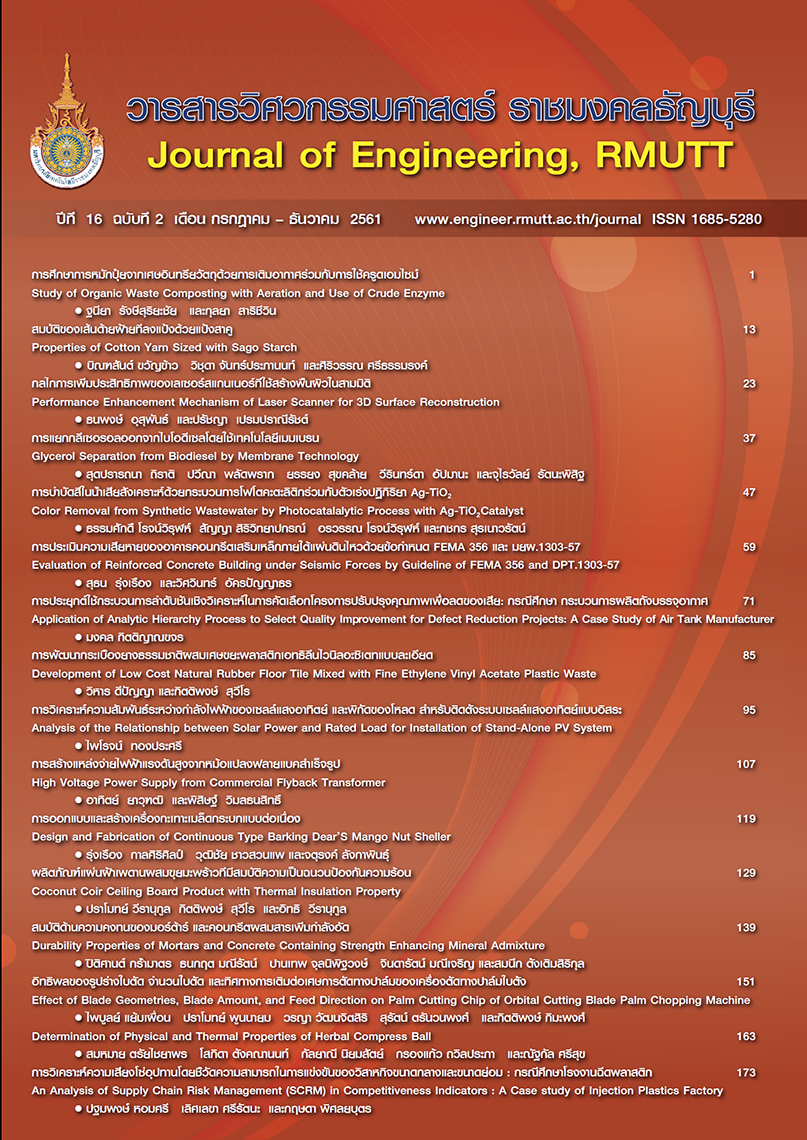Durability Properties of Mortars and Concrete Containing Strength Enhancing Mineral Admixture
Main Article Content
Abstract
This research was aimed to study the durability properties of concrete containing strength enhancing mineral admixture (SA). The SA was used to add and partial replacement of 5.5, 6.5 and 7.5% by weight in Portland cement type 1 (OPC). Dry shrinkage of mortar, carbonation of concrete, resistance to chloride penetration of concrete and sulfate resistance of mortar were considered. The study found that the drying shrinkage of mortar with fly ash was rather small when compared to that of OPC mortar. Also, drying shrinking of mortar containing SA was less than that of the OPC mortar, especially when mixed in greater quantities. The drying shrinkage of mortar contained SA addition was likely that less of mortar containing SA with partial replaced. Furthermore, the carbonation of concrete with fly ash was greater than that of OPC concrete. The carbonation of concrete contained SA addition was lesser than that of OPC concrete whereas the carbonation of concrete containing SA with partial replaced was higher. By adding SA was used in greater quantities, the carbonation of concrete had increased. In addition, the resistance to chloride penetration of concrete with fly ash and containing SA was better than that of OPC concrete. Moreover, the more SA was mixed, the better to resist the penetration of chloride occurred. The resistance to chloride penetration of concrete contained SA addition was lower than that of concrete containing SA with partial replaced. Finally, the expansions in sodium sulfate solution of type V cement mortar, mortar with fly ash and mortar containing SA with partial replacement were lesser than those of OPC mortar, while its expansion of mortar contained SA addition was no different to that of OPC mortar. The different of using SA quantity, the expansion in sodium sulfate solution of concrete was no different. The weight loss in magnesium sulfate solution of
type V cement mortar and mortar containing SA was lesser than that of OPC mortar. While the weight loss of mortar with fly ash was greater than that of OPC mortar. The different of using SA quantity, the weight loss in magnesium sulfate solution of mortar was no different.
Article Details
The manuscript, information, content, picture and so forth which were published on Frontiers in engineering innovation research has been a copyright of this journal only. There is not allow anyone or any organize to duplicate all content or some document for unethical publication.
References
Julnipitawong P, Tangtermsirikul S. Investigation on Performance of Concrete and Mortar Using Active Chemical Compound Rockfil-HSM. Final Report Submission to BKG Group Corporation. 2013.
Julnipitawong P, Tangtermsirikul S. A Study on Effect of Strength Accelerating Compound on Properties of Concrete and Mortar. volume 2, No. 1, January – June 2014; pp. 17-29.
Thai Industrial Standard. TIS 15-2555; Portland Cement Part 1 Specification. Ministry of Industry. Bangkok. 2012. (in Thai)
Thai Industrial Standard. TIS 2135-2545; Coal Fly Ash for Use as an Admixture in Concrete. Ministry of Industry. Bangkok. 2002. (in Thai)
American Society for Testing and Materials. ASTM C 596 - 01: Standard Test Method for Drying Shrinkage of Mortar Containing Hydraulic Cement. Annual Book of ASTM Standards. 2001.
American Society for Testing and Materials. ASTM C 109 - 07: Standard Test Method for Compressive Strength of Hydraulic Cement Mortars (Using 2-in. or [50-mm] Cube Specimens). Annual Book of ASTM Standards. 2007.
American Society for Testing and Materials. ASTM C 856 - 04: Standard Practice for Petrographic Examination of Hardened Concrete. Annual Book of ASTM Standards. 2004.
American Society for Testing and Materials. ASTM C 1202 - 12: Standard Test Method for Electrical Indication of Concrete's Ability to Resist Chloride Ion Penetration. Annual Book of ASTM Standards. 2012.
American Society for Testing and Materials. ASTM C 1012 - 04: Standard Test Method for Length Change of Hydraulic-Cement Mortars Exposed to a Sulfate Solution. Annual Book of ASTM Standards. 2004.
Al-Amoudi, O. S. B.. Mechanisms of Sulfate Attack in Plain and Blended Cement: a Review. Proceeding of the International Seminar. September 1999. University of Dundee, Scotland, UK. pp. 247-260.


